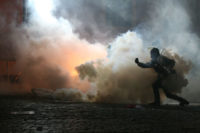While most commonly associated with the aviation world, the checkpoint is now a major component of almost every security strategy. Whether it’s a major sporting event like the Olympics or the Super Bowl or a high-security facility like a government building or nuclear power facility, checkpoints have spread far-and-wide beyond the confines of the airport. While these practices may no longer be exclusive to airports, aviation still has a few tricks to teach the rest of the security world when it comes to operating an effective and efficient security checkpoint.
In reality, the lessons being taught by emerging practices within aviation security checkpoints should be closely watched by other industries, in particular transportation and sporting events. Threats thought to be aviation-specific can easily spread to other sectors, so learning to deal with these issues and adapting the best practices set down by airport security professionals can ensure that other checkpoints, regardless of purpose, are ready to meet new security threats head on.
So what exactly are the new lessons being taught by aviation security checkpoints?
The Need for Speed
One major airport security lesson that should be taken note of is speed. While not associated with the checkpoint directly, baggage screening has always been an important, albeit frustrating, component of aviation security. Complicating matters is that a baggage screening system is typically a separate system from the primary baggage handling solution, and often runs at a far slower throughput, a problem that aviation has been working hard to overcome.
Now, it seems like the aviation world might have a solution to slow baggage screening in the form of ultra-high-speed baggage scanning technologies. The systems run at the same speed as the primary handling system and use advanced X-ray scanners and automated threat detection to swiftly pinpoint potential threats without holding up the overall operation.
While this might seem very airport-specific, the principles are easily applied to other industries, most notably other forms of transportation, like rail. While high-speed rail has been slow to take hold in the United States, it’s a primary transportation mode in the rest of the world … and a prime target for terror attacks. Adding in the high-speed screening lessons learned from airports will make rail travel safer without slowing it down.
The air cargo industry should also take note of the high-speed screening revolution in the passenger aviation world. Forwarders and shipping companies are constantly looking for ways to meet international security compliance mandates without slowing down operations, and high-speed scanning gives them just such a solution.
“Unorthodox” Technologies
After speed, security professionals outside of aviation should also look at the use of unorthodox and non-security technologies within checkpoints. Manchester Airport in the United Kingdom, for instance, estimates that it has saved 25–40 percent on operating costs and labor just through the implementation of a few simple, under-utilized pieces of technology.
So what is meant by unorthodox?
Signage is one example; nothing security-specific here, just simple, well-marked signs directing people on where to stand and what do within the checkpoint line. While this sounds ridiculous, the truth is that many security checkpoints in the US, both aviation and otherwise, don’t pay enough attention to signage, and throughput suffers as a result of the ensuing confusion.
Alongside improved signage, non-security automation should also be considered. Manchester Airport uses a variety of automated technologies to improve throughput and customer satisfaction, very few of which are in use stateside. Technologies like automated bin returns for easier divesture, ensuring that a bin is always within a customer’s reach, can go a long way in this regard.
Additionally, security professionals should consider automated gating and signaling systems, which alert customers when to enter, pause and leave a checkpoint, removing frustrations inherent in some interpersonal interactions at checkpoints.
Don’t Forget to Train
Too often, non-aviation security checkpoints do not stress a major component of any successful checkpoint operation: training. The aviation world typically does a fantastic job of understanding how to train operators on not just using checkpoint technologies, but also threat identification and crowd management, a key lesson of which all security teams should take note.
Checkpoints are not a “mean guard and a magnet” anymore – they are composed of sophisticated pieces of machinery that, while effective in and of themselves, need quality operators to actually be truly efficient. Manufacturers often provide both built-in and modular tools with their technologies to help with training, but too often they fall by the wayside or are under-utilized. Aids like threat image projections, which project the images of simulated threat objects onto an X-ray machine, can not only help improve the checkpoint process, but actually improve overall security at the same time.
Aviation checkpoints are obviously very different from checkpoints in other industries – the scale and scope of threats along with the type of customer screened vary greatly depending on the sector. But the general technologies and principles laid down by the aviation security world are not aviation-specific and can be easily adapted into other industries to improve the overall quality of the security checkpoint. The lessons are there; industries outside of aviation just have to take note.






